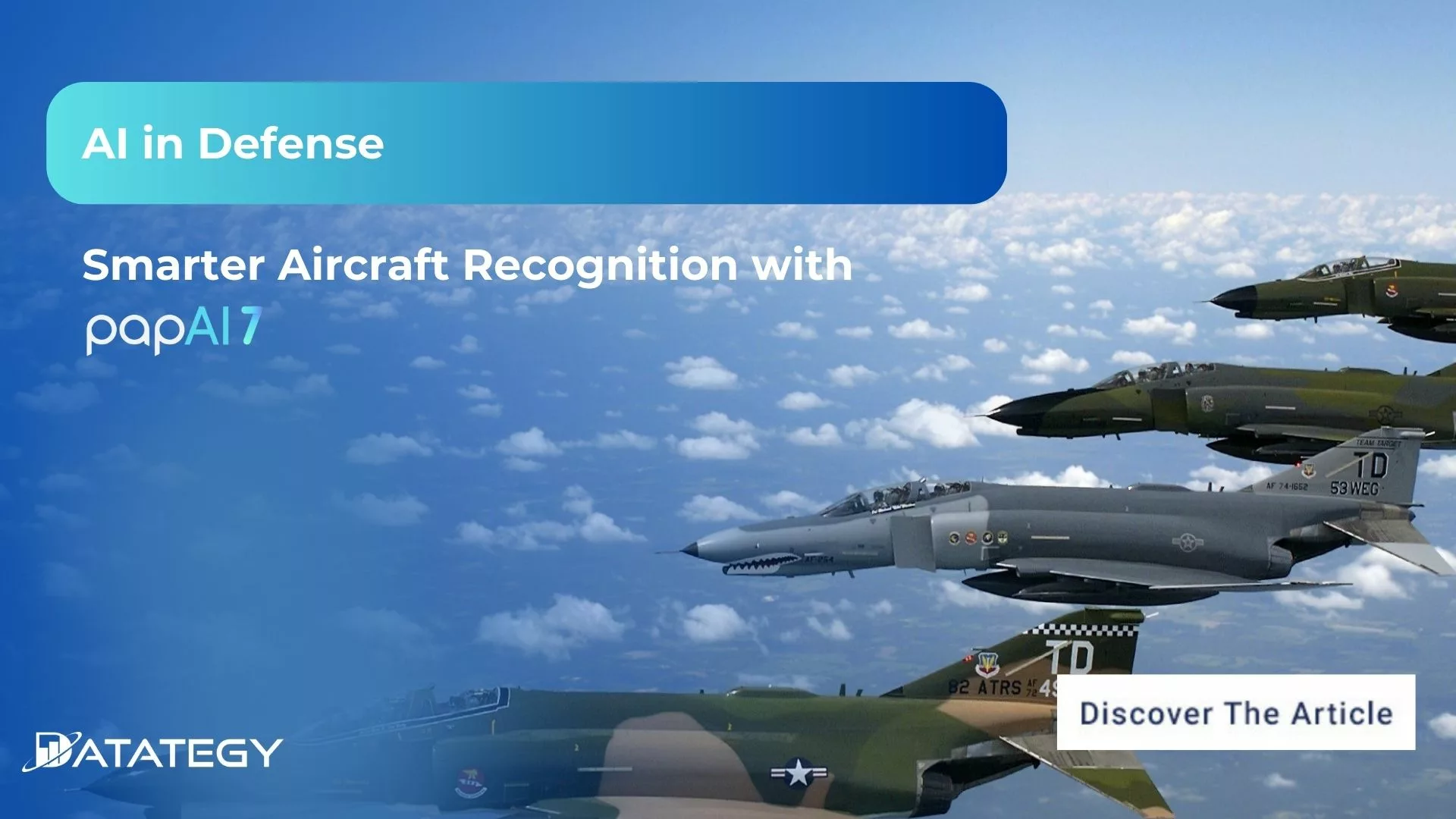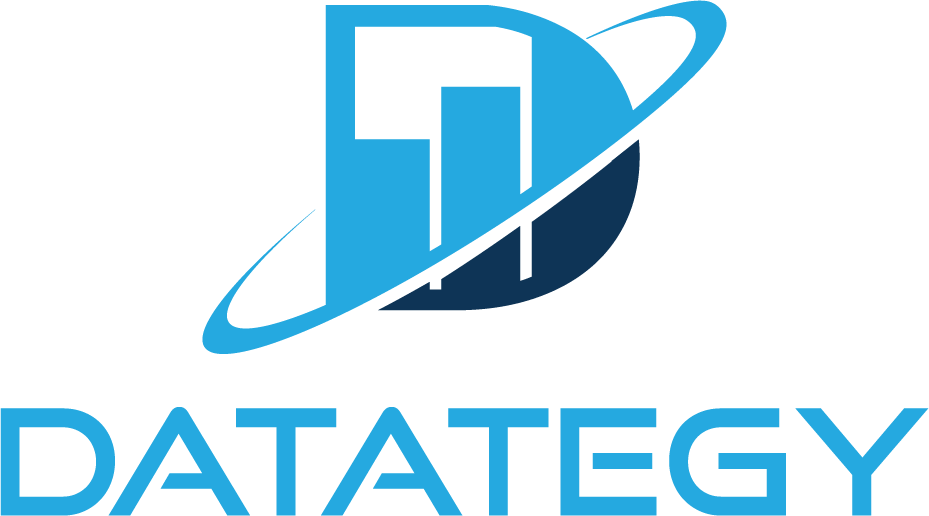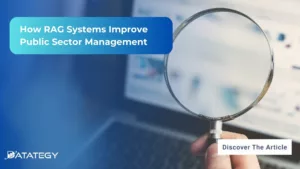How Law Firms Use RAG to Boost Legal Research RAG...
Read MoreAI in Defense: Smarter Aircraft Recognition with papAI 7
Table of Contents
ToggleThe defense sector is not an exception to the rule that artificial intelligence (AI) is actively changing industries. It is no longer just a catchphrase. Artificial intelligence (AI) is becoming increasingly important in modern military operations, from improved surveillance to more intelligent decision-making on the battlefield. Aircraft recognition is one of the most notable uses of AI in defense, serving as a vital component for both strategic advantage and national security.
Recent research found that AI can take over dangerous tasks, reducing the risk to human soldiers by 30% (Source.Rocket.chat)
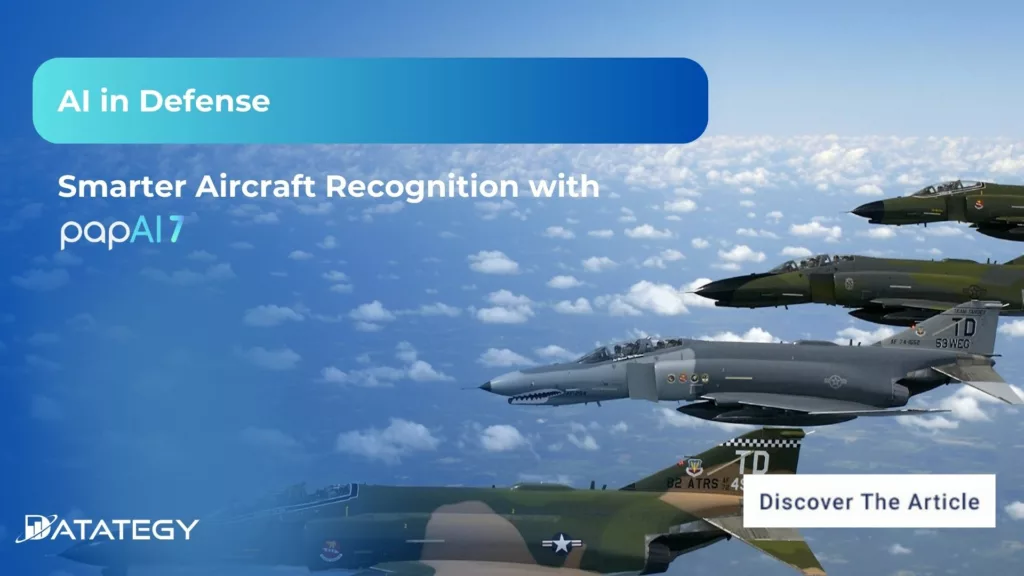
In this article, we’ll explore how AI, and specifically papAI7, can streamline and enhance the process of aircraft recognition.
Military Operations and AI Opportunities
Logistics and purpose-driven mission planning
In order to ensure that resources are allocated profitably and that multiple missions, operations, or task forces are coordinated, combine environmental, asset, and historical mission data to better predict mission scenarios. Determine the best locations for camps and supply routes for evacuation in the event of a military or humanitarian emergency.
Intelligence with data
To provide a clearer picture of a conflict or crisis dynamic, integrate artificial intelligence (AI) into the gathering and interpretation of satellite and drone surveillance data feeds, taking historical mission data, environmental factors, and more into account. Use reinforcement learning algorithms to improve autonomous vehicles, such as land machines and submarines, so they can conduct reconnaissance and find targets.5.
Predictive asset maintenance with confidence
Employ computer vision and sensor technologies to find equipment defects and system failures early on. Reduce accidents and unscheduled delays by using deep learning and planning algorithms to establish maintenance schedules based on operating standards for different components. In order to develop better management and maintenance strategies, combine and evaluate real estate assets.
Enhanced operations with precision
AI is changing the game for military operations because it can automate repetitive tasks and data analysis. Soldiers and analysts have historically devoted many hours to handling logistics, sorting through data, and carrying out monotonous tasks. With AI, a large portion of this labour is automatically completed, from real-time equipment and logistics system monitoring to the analysis of security footage.
The Main AI Technologies used in the Defense Sector
Computer Vision
Machines can now interpret and comprehend visual data from their surroundings thanks to the revolutionary technology known as computer vision.
This technology is essential to the defense industry’s surveillance and reconnaissance efforts. In order to identify and track objects like vehicles, people, or suspicious activity, for example, sophisticated computer vision algorithms can analyze real-time video feeds from drones or security cameras. This ability is crucial for preserving situational awareness and guaranteeing military operations’ safety.
Computer vision in defense can help with automated threat identification in addition to basic object detection. These systems can be trained to identify particular patterns or anomalies in imagery, like unauthorized entry into restricted areas or the presence of concealed weapons,
by utilizing deep learning techniques. By doing this, security is improved and the workload for human operators is lessened, freeing them up to concentrate on making strategic decisions as opposed to manual monitoring.
Natural Language Processing
The foundation of contemporary AI is natural language processing, or NLP, which enables machines to comprehend, interpret, and produce human language.
By analyzing enormous volumes of textual data from various sources, including social media, intelligence reports, and intercepted communications, natural language processing (NLP) improves intelligence gathering in the defense industry. NLP can analyze this data and extract important information, spot trends, and offer insights that are critical for threat assessment and strategic planning.
When working with foreign intelligence or in multinational operations, natural language processing (NLP) is especially helpful in translating and summarising information across multiple languages. NLP-powered automated translation and summarisation systems can swiftly turn massive textual volumes into actionable intelligence, cutting down on the time it takes for human analysts to comprehend and react to important data.
By doing this, decision-making can be completed more quickly and accurately, and defense operations can be supported by the most up-to-date, pertinent information possible.
Predictive Analytics
Predictive analytics is a potent tool in defense applications because it forecasts future events and trends by utilizing sophisticated algorithms and historical data.
Predictive analytics can help anticipate equipment failures, optimize maintenance schedules, and enhance logistical planning by analyzing patterns and trends in data. Defense companies, for instance, can use predictive models to anticipate when a specific piece of equipment is likely to need maintenance, avoiding unplanned malfunctions and guaranteeing operational readiness.
By combining historical trends with real-time data, predictive analytics improves situational awareness. For instance, predictive models can offer insights into potential future developments by keeping an eye on the conditions on the battlefield and comparing them with historical data.
This enhances the overall efficacy of defense operations by assisting commanders in making well-informed decisions, adjusting to shifting circumstances, and acting faster in the face of new threats.
Applications of Computer Vision in Defense Sector
Monitoring in Real Time
Real-time surveillance relies heavily on computer vision technology to process and analyze live video feeds from satellites, ground-based cameras, and drones. Large regions can be continuously monitored by these systems, which can identify any odd movements or activities that might indicate possible threats. Computer vision improves situational awareness and enables military personnel to react to changing circumstances faster by utilizing sophisticated algorithms.
In real life, computer vision systems are able to recognize and follow objects of interest, like people or cars, even in difficult settings. For instance, these systems can still offer insightful information and alerts when operating at night or in low visibility. This ability contributes to ensuring that current and accurate information is used to inform military operations.
Identifying Targets Automatically
Using computer vision for automated target identification greatly expedites the process of identifying and categorizing objects from visual input. These systems employ complex algorithms to distinguish between different targets, such as enemy vehicles, military hardware, and civilian objects, rather than depending only on human observation. By increasing accuracy and reducing errors, this automation makes sure that the right targets are identified.
In combat situations, for example, computer vision can examine picture or video streams to identify enemy locations or weaponry while removing insignificant or non-threatening objects. By eliminating the need for manual target identification, this capability frees up military personnel’s cognitive load so they can concentrate on making strategic decisions.
Damage Evaluation
Computer vision plays a critical role in determining the extent of damage to equipment and infrastructure following a natural disaster or military conflict. Computer vision systems are capable of assessing the level of destruction, identifying damaged assets, and assessing the impact on operational capabilities through the analysis of images or video footage of affected areas. Repair and recovery efforts can be prioritized with the help of this quick assessment.
Computer vision, for instance, can evaluate structural damage to buildings or facilities, giving precise information about the extent of the damage. By providing this data, military planners and engineers can make well-informed decisions regarding the allocation of resources and necessary repairs, resulting in more effective and efficient recovery operations.
Guidance and Preventive Measures
Computer vision is a critical component for safe navigation and obstacle avoidance in autonomous military vehicles and drones. Computer vision systems are able to identify and modify the path of a vehicle in response to obstacles like trees, rocks, and buildings by evaluating visual data obtained from onboard cameras and sensors. This feature guarantees that autonomous systems can move through intricate environments without running into roadblocks.
Drones with computer vision capabilities, for example, can fly safely over difficult terrain during reconnaissance missions or search-and-rescue operations by avoiding obstacles and modifying flight paths in real-time. This accuracy guarantees that there won’t be any mishaps and that the mission can continue without any delays or equipment damage.
A to Z of Generative AI: An in-Depth Glossary
A form of artificial intelligence called “Generative AI” enables machines to produce text, pictures, and music on their own. By automating activities, improving customization, and encouraging innovation, it is revolutionizing industries by using the power of algorithms and deep learning. This guide will provide you with a solid foundation in Gen AI terminology to help you better understand this exciting field.

Use Case: Military Aircraft Recognition using papAI
Overview of papAI 7
papAI is a comprehensive AI solution designed to facilitate the seamless deployment and scaling of data science and AI projects by businesses. papAI was created with teamwork as its primary focus. It enables groups to collaborate effectively on a single platform, simplifying challenging jobs and optimizing workflows.
It provides a comprehensive set of tools, including sophisticated machine learning methods, model deployment choices, data visualization, exploration, and robust data cleaning capabilities—all conveniently located in one location. Organizations can take on their most difficult projects with PapAI and maintain their agility and competitiveness in the rapidly changing AI market.
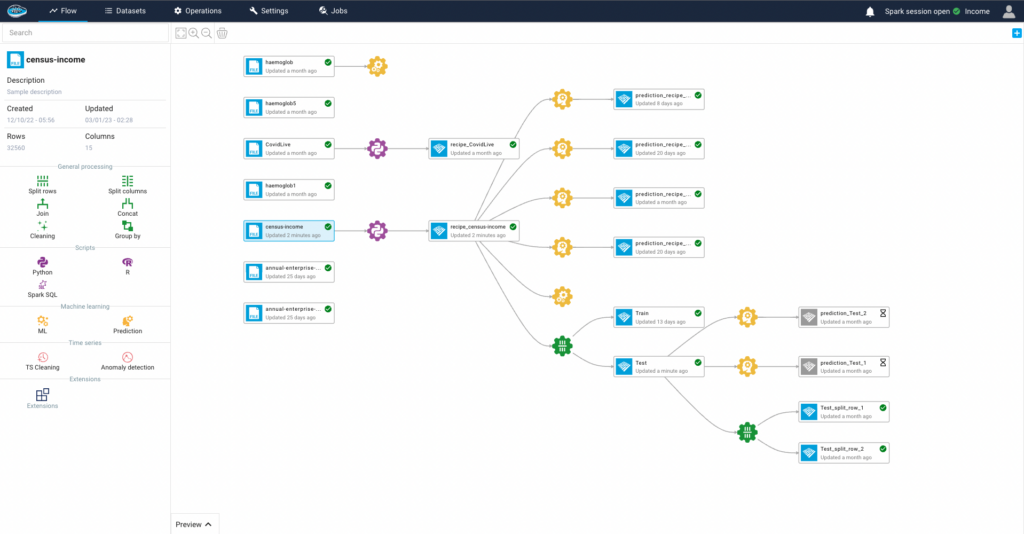
Context
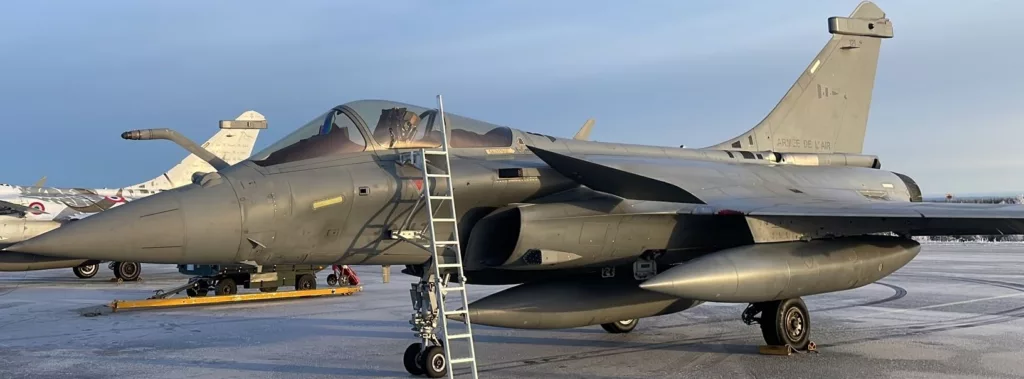
Rafale
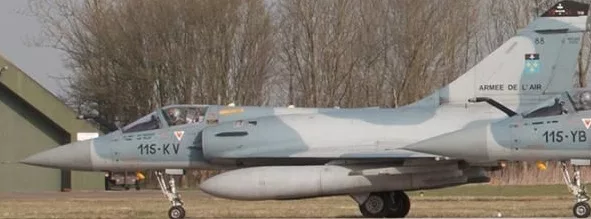
Mirage2000
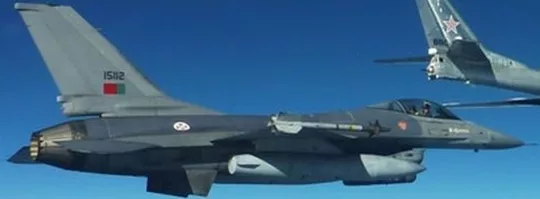
F-16
Computer vision is a critical component for safe navigation and obstacle avoidance in autonomous military vehicles and drones. Computer vision systems are able to identify and modify the path of a vehicle in response to obstacles like trees, rocks, and buildings by evaluating visual data obtained from onboard cameras and sensors. This feature guarantees that autonomous systems can move through intricate environments without running into roadblocks.
For this use case, we are collecting around 1500 images from 3 different aircrafts :
- Two french models, the Rafale and the Mirage2000.
- One American, the F–16.
1. Importing aircraft images
We must first recover images from each type of aircraft before moving on to the model training. Using papAI, you can import any kind of data from a variety of sources, including your local computer, external databases, APIs, and even our implemented Python, R, or SQL scripts for creating your own dataset. In order to organise these photos into folders for each category and prepare them for the Labelling step, we are now introducing buckets.
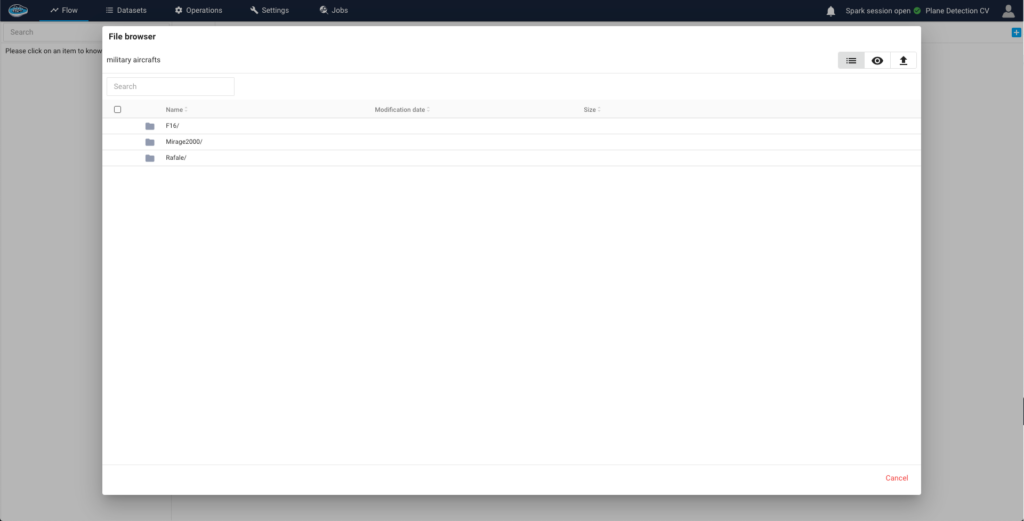
2. Examine the pictures
Once your images have been imported and sorted into the appropriate folder, you can use your bucket’s Preview mode to review them if necessary. In order to fix your inputs, you can also choose to download or remove one or more images.
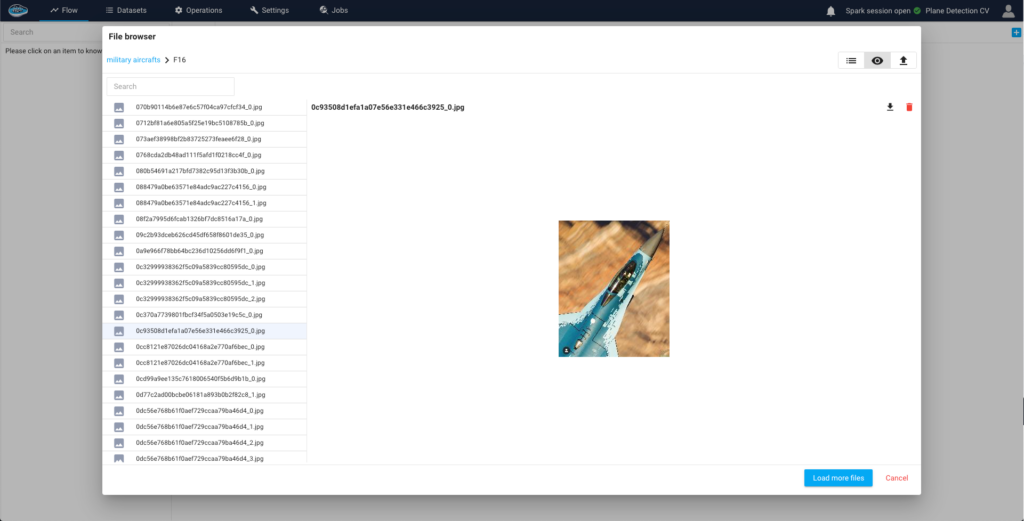
3-Labeling each aircraft image
This is a crucial step in order to determine which image belongs to which aircraft and make the best prediction. Therefore, in the Labelling step, papAI automatically recognises the bucket’s structure with its various folders in order to accurately label every image. All of these images are then gathered into an output dataset, which is prepared for use in training your image classification model.
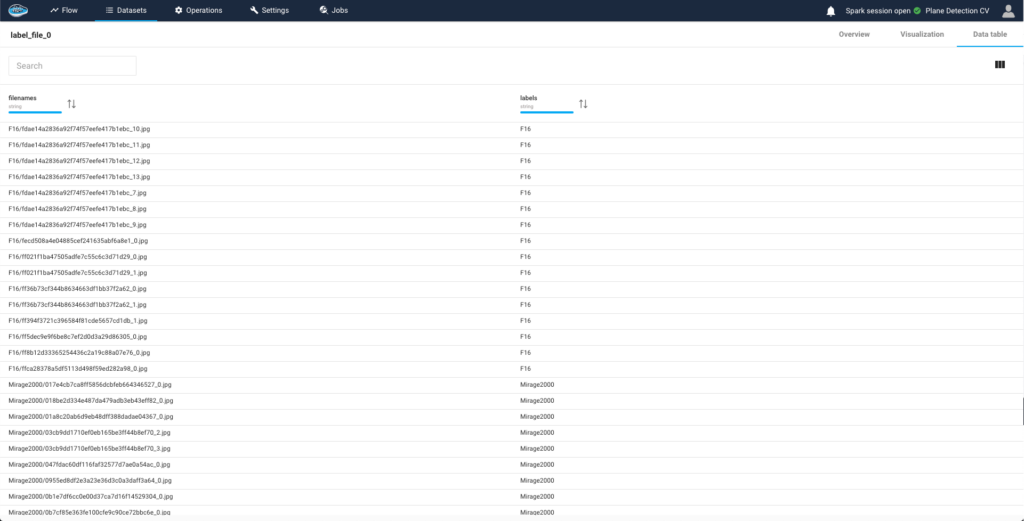
4-Model training
Once your photos have been labelled, you can start testing out models that can identify individual aircraft. You will be presented with image classification algorithms, such as Resnet, along with some settings to adjust and image augmentation to help improve the accuracy and resilience of your model after choosing the dataset and executing the AutoML module.
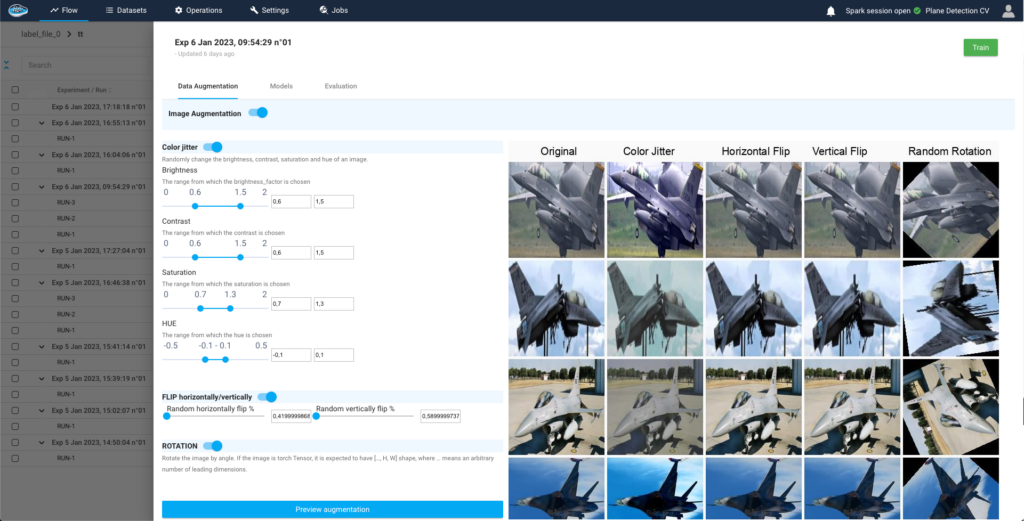
5. Model assessment
When your model is finished, you can easily assess its performance on your own using the Evaluation module, which includes metrics and graphs like Accuracy rate and loss. After configuring your model, you can view the Live Metrics to monitor it in real time by epoch while the model is being trained.This model has an 85% accuracy rate.
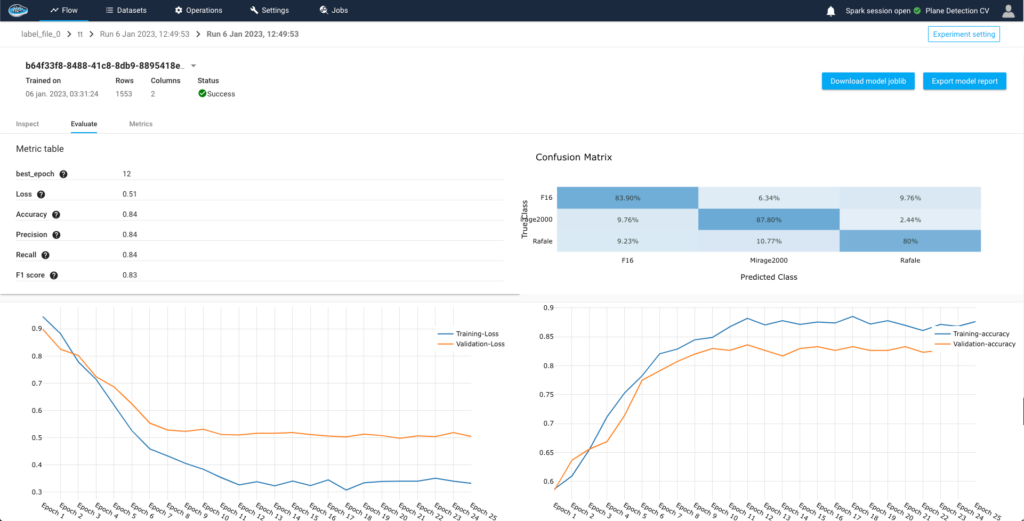
6-Prediction on test dataset
You may allow the model to make predictions on any dataset or image you import into your project if you are happy with the outcomes. In our instance, we applied the prediction operation after importing an additional set of arbitrary images that included the three aircraft models. The process yields an output dataset with the predicted aircraft for each image and the probability of each aircraft model. A heatmap can even be used to further clarify which areas of the picture contribute to the expected result. The papAI platform has identified the aircraft in the first picture below as an F-16 with 100% accuracy.
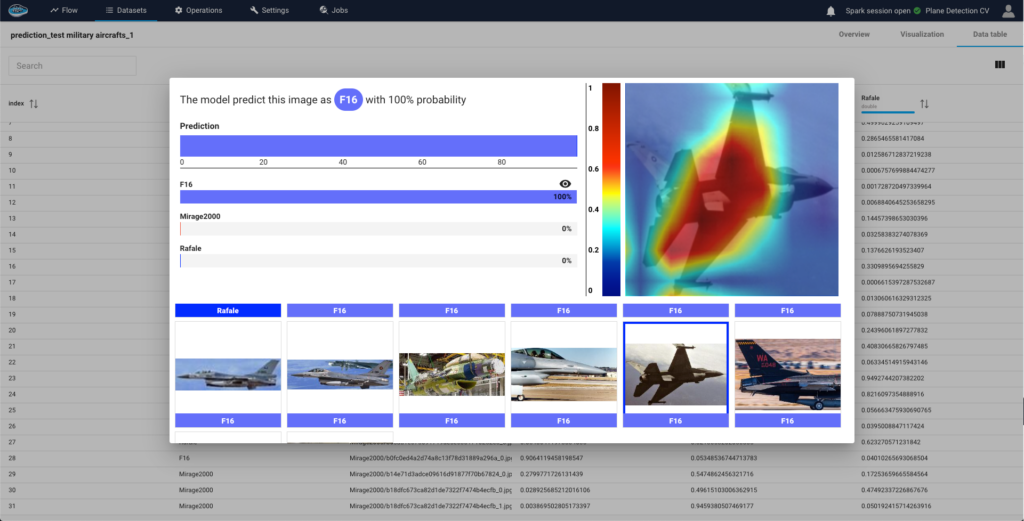
In the second image the platform detects with 98% accuracy a Mirage2000.
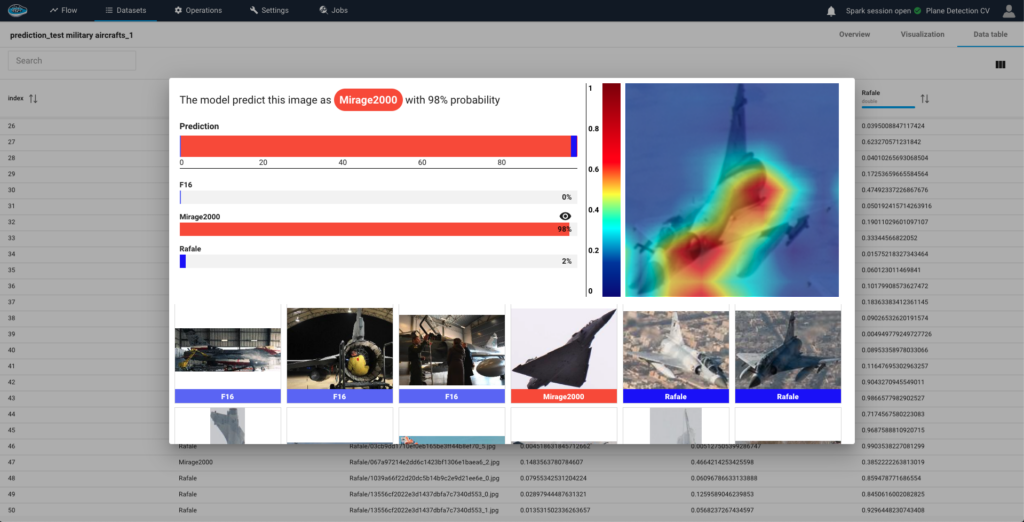
To sum up, papAI platform has the potential to completely transform military aircraft identification by making it quicker, more accurate, and more efficient. With the use of predictive machine learning algorithms, it is able to accurately identify aircraft based on their visual and physical characteristics.
One of the main benefits of utilizing AI for military aircraft recognition is its capacity to process massive volumes of data fast and reliably, making aircraft identification quicker and more effective. Furthermore, the papAI platform can handle various data sources and adjust to changing conditions, which can increase the system’s accuracy and flexibility.
Create your own AI platform to meet your Specific Use Cases
papAI7 is designed to empower defense organizations with the tools needed to address critical use cases. From enhancing real-time surveillance to automating decision-making processes, papAI offers the flexibility and scalability to meet the unique demands of defense operations.
With its user-friendly interface and advanced capabilities, papAI enables teams to build, deploy, and manage AI applications that enhance mission success and operational efficiency.
Book a demo today and explore how our platform can help you build powerful AI applications tailored to your specific defense needs.
Interested in discovering papAI?
Our AI expert team is at your disposal for any questions
How RAG Systems Improve Public Sector Management
How RAG Systems Improve Public Sector Management The most important...
Read MoreScaling RAG Systems in Financial Organizations
Scaling RAG Systems in Financial Organizations Artificial intelligence has emerged...
Read MoreHow AgenticAI is Transforming Sales and Marketing Strategies
How AgenticAI is Transforming Sales and Marketing Strategies Agentic AI...
Read More